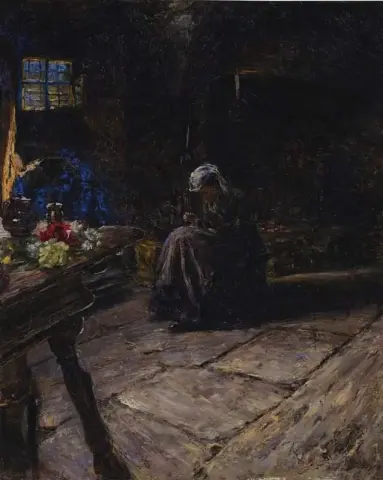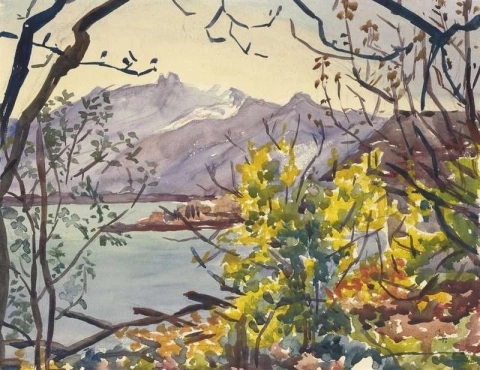

Hand painted reproductions of Giovanni Giacometti
Giovanni Giacometti: A Pioneer of Modernist Landscape Painting
Giovanni Giacometti (1868–1933) was a Swiss painter renowned for his innovative approach to landscape painting, bridging the gap between the naturalist tradition and the modernist movements of the early 20th century. His works often displayed an intimate understanding of his native Swiss Alps, captured in a style that conveyed both the grandeur of nature and the nuances of light and atmosphere. Through his distinctive treatment of the landscape, Giacometti contributed significantly to the evolution of modern Swiss art, gaining recognition for his contributions to both the Fauvist and early Expressionist movements.
Early Life and Education
Born in the village of Stampa in the canton of Graubünden, Switzerland, in 1868, Giovanni Giacometti grew up in an environment deeply immersed in the beauty of the Alps. His family background played a pivotal role in his early exposure to the arts, with his father, Giovanni Giacometti Sr., being a talented artist in his own right. Encouraged by his family, Giovanni Giacometti began his formal education at the School of Fine Arts in Milan, where he honed his skills in drawing and painting.
After completing his studies, Giacometti traveled extensively through Europe, absorbing the artistic influences of Italy, France, and Germany. His time in Paris, where he interacted with key figures in the modernist movement, exposed him to various avant-garde styles, including Fauvism and early Expressionism. Giacometti’s exposure to these movements was instrumental in shaping his approach to color, form, and his evolving landscape works.
Artistic Development and Style
Giovanni Giacometti’s artistic style was characterized by its use of vivid colors and bold brushwork, elements that drew from the modernist movements he encountered in Paris. However, unlike many of his contemporaries who favored abstraction, Giacometti retained a focus on the natural world, particularly the landscapes of his homeland.
His early works followed the naturalist tradition, portraying the serene and picturesque Swiss countryside with great attention to detail. However, as his artistic vision evolved, he began to incorporate more expressive techniques, influenced by Fauvism. The rich, vibrant colors that dominated his landscapes were used not only to capture the beauty of nature but also to convey his emotional response to the scenes he painted. His brushwork became more dynamic, with bold, sweeping strokes that imbued the landscapes with a sense of movement and energy.
Giacometti’s landscapes were often imbued with a sense of isolation and contemplation, as he captured the Swiss Alps with a deep, almost spiritual reverence. The mountains and valleys were not just physical locations but symbols of the emotional and psychological state of the artist. His works revealed a personal connection to the land, with the majesty of nature portrayed as both a literal and symbolic reflection of the human experience.
Themes and Significance
Giovanni Giacometti’s landscapes were a direct reflection of his deep connection to his native Switzerland. The towering mountains, rolling hills, and alpine meadows were often the central subjects of his paintings, but they were depicted not merely as physical locations. The landscapes were treated as vibrant, almost living entities that evoked a sense of awe and introspection.
One of the defining features of Giacometti’s work was his ability to depict the interplay of light and shadow within the landscape. He often painted during the early morning or late afternoon, when the natural light created dramatic contrasts and deep shadows. This attention to the effect of light on the landscape added an emotional layer to his paintings, evoking feelings of solitude, tranquility, and a profound sense of place.
In addition to his depictions of the natural world, Giacometti explored themes of the human figure and identity in relation to the landscape. Some of his later works feature solitary figures set against the vastness of the Swiss Alps, symbolizing the individual’s struggle and connection to the larger world. These figures, often depicted in a simplified and almost abstract manner, added a symbolic dimension to his paintings that aligned with the Expressionist movement.
Achievements and Influence
Giovanni Giacometti’s work was recognized in Switzerland and internationally for its innovative approach to landscape painting. He exhibited regularly at the Salon d'Automne in Paris and was associated with the Fauvist movement, which embraced bold color and expressive brushwork. His connection to the modernist trends of the early 20th century helped him gain recognition as a pioneer of Swiss modernism.
While his work did not receive the same widespread acclaim as some of his contemporaries, such as the major French modernists, Giacometti's contributions to Swiss art were significant. His work was celebrated for its unique fusion of color, light, and emotion, as well as for its ability to transcend the purely representational in favor of a more personal, expressive interpretation of nature.
Giacometti’s legacy is also tied to his role as a teacher and mentor. He influenced several prominent artists, including his son, Alberto Giacometti, who went on to become one of the most renowned sculptors of the 20th century. Giovanni Giacometti’s ability to convey emotional depth and a profound connection to the natural world left an enduring impact on the art world, especially in Switzerland.
Legacy
Giovanni Giacometti’s legacy as a landscape painter is one of emotional depth and modernist innovation. His works continue to be celebrated for their vivid use of color, dynamic brushwork, and profound connection to the Swiss landscape. Giacometti’s paintings are regarded as key examples of Swiss modernism and are considered invaluable for their historical and artistic significance.
Today, Giovanni Giacometti’s works can be found in major collections in Switzerland and abroad, where they are admired for their blend of naturalism and modernist expression. His landscapes remain a testament to the beauty and majesty of the Swiss Alps, as well as to his unique ability to convey the emotional and symbolic resonance of nature.
Where to Find Reproductions of Giovanni Giacometti’s Art
For those wishing to bring the emotional and scenic beauty of Giovanni Giacometti’s landscapes into their own homes, POD (Painting On Demand) offers high-quality oil painting reproductions. These paintings bring the serene beauty of the Swiss Alps into your living space, offering a timeless connection to Giacometti’s visionary artistic style.
Imagine owning an original-style painting by one of the greatest artists in history. At POD, we offer you the chance to make this dream a reality. Each canvas is faithfully reproduced down to the smallest detail, allowing you to experience the beauty of the artist’s vision in your own home.
Our reproductions are crafted by experienced painters using the finest materials and time-honored methods. We are committed to delivering works of exceptional quality that will inspire and bring joy to your family for generations to come.








































